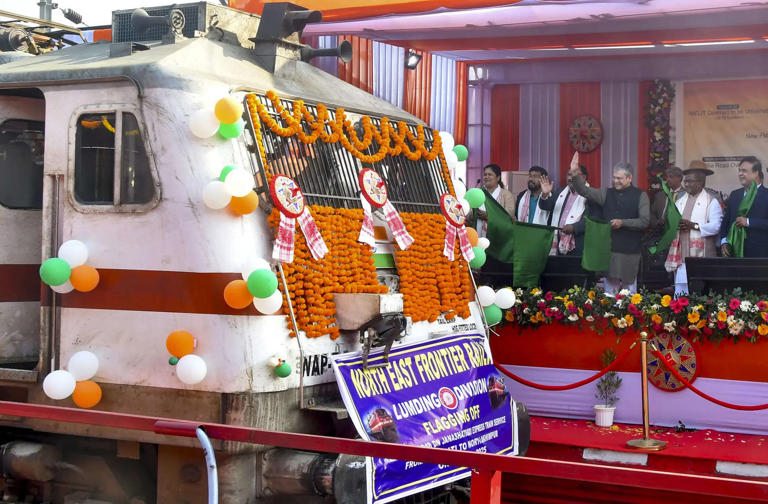Union Minister for Railways, Communications, and Electronics & IT, Ashwini Vaishnaw, recently flagged off three new trains in Assam, signaling a significant step towards improving rail connectivity in the northeastern region. The inauguration ceremony, held at Guwahati Railway Station, was attended by state officials, railway authorities, and local dignitaries. These new trains are part of the Indian Railways’ ongoing efforts to strengthen infrastructure and promote economic growth in the northeastern states.
New Trains to Foster Regional Integration
The three newly introduced trains are the Guwahati-Naharlagun Intercity Express, the Dibrugarh-New Jalpaiguri Jan Shatabdi Express, and the Jorhat Town-Tinsukia Passenger Special. Each train has been designed to address the unique travel needs of the region, offering enhanced connectivity, improved comfort, and reduced travel times.
- Guwahati-Naharlagun Intercity Express: This train connects Assam’s capital Guwahati with Naharlagun in Arunachal Pradesh, a key link that is expected to facilitate trade and tourism between the two states. The service will operate six days a week, providing a reliable option for commuters and travelers.
- Dibrugarh-New Jalpaiguri Jan Shatabdi Express: Designed for long-distance travelers, this semi-high-speed train connects Dibrugarh, a major city in Upper Assam, with New Jalpaiguri in West Bengal. Equipped with modern amenities, including air-conditioned coaches, the train aims to reduce travel time and enhance passenger convenience.
- Jorhat Town-Tinsukia Passenger Special: This short-distance service is tailored to meet the daily commuting needs of passengers in Upper Assam. By connecting Jorhat Town with Tinsukia, the train is expected to ease local travel and boost economic activity in the region.
Enhancing Northeast’s Rail Network
Speaking at the event, Vaishnaw emphasized the government’s commitment to accelerating infrastructure development in the Northeast. “The introduction of these trains is a testament to our vision of ensuring seamless connectivity for the people of the Northeast. Railways are not just a mode of transport but a lifeline that connects communities and drives economic growth,” he said.
The Northeast has historically faced challenges in rail connectivity due to its difficult terrain and geographical isolation. However, the region has witnessed a transformation in recent years, thanks to increased investments and focused initiatives under the central government’s “Act East” policy. The Indian Railways has played a pivotal role in this transformation by extending rail lines, modernizing infrastructure, and introducing new services.
Economic and Social Impact
The new train services are expected to have a far-reaching impact on Assam and the surrounding states. By improving connectivity, they will facilitate the movement of goods, bolster trade, and attract investment. The Guwahati-Naharlagun Intercity Express, in particular, is poised to boost tourism in Arunachal Pradesh, a state known for its scenic beauty and cultural heritage.
Local businesses stand to benefit from enhanced access to markets, while residents will enjoy greater mobility for work, education, and healthcare. The Dibrugarh-New Jalpaiguri Jan Shatabdi Express is also likely to enhance regional integration by connecting Assam with West Bengal, a critical economic and cultural hub.
Challenges and Opportunities
Despite these developments, challenges remain in further enhancing rail infrastructure in the Northeast. The region’s hilly terrain, heavy monsoon rains, and ecological sensitivity require innovative engineering solutions and sustainable practices. Vaishnaw acknowledged these challenges, stating, “We are committed to overcoming these obstacles with advanced technology and strategic planning. The Northeast deserves world-class infrastructure, and we will deliver it.”
At the same time, the introduction of these new trains opens up opportunities for tourism, trade, and cultural exchange. The improved rail network can serve as a backbone for the Northeast’s development, unlocking its potential as a gateway to Southeast Asia.
Public Reception and Future Plans
The announcement was met with enthusiasm by the public and local stakeholders. Passengers expressed excitement about the improved services, highlighting the convenience and time savings offered by the new trains.
The Indian Railways has ambitious plans for the Northeast, including electrification of rail lines, introduction of high-speed rail services, and further expansion of the network to remote areas. Vaishnaw reiterated the government’s resolve to continue investing in the region, with several projects already in the pipeline.
Conclusion
The flagging off of three new trains in Assam marks a significant milestone in India’s efforts to enhance rail connectivity in the Northeast. By bridging distances and fostering regional integration, these trains are set to transform lives and fuel economic growth. As the Northeast continues its journey towards becoming a hub of development and prosperity, the railways will undoubtedly play a central role in shaping its future.


